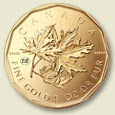I’ve been an avid collector of gold and silver coins and have been following the prices for a years.
Gold is supposed to have a negative correlation with the stock market. This year has proved otherwise. Of course, as we’ve seen repeatedly in the past, all asset classes correlate to the downside.
Gold which peaked at $1030/oz earlier this year, has been trading in the $700 range for a few months. There has been a flight to safety, which for most people means buying US Treasuries. Indeed, the flight has been so large that it has pushed the yields down to absurdly low levels. The yield on the 3-month Treasury was almost zero at 0.4% and the 10 year is 3.52%. (The yield on the S&P500 was 3.55% this week, higher than the 10 year Treasuries rate for the first time since 1958).
The way that demand affects interest rates is that as people clamor for T-bills, they push up the prices for these bonds. Since the bonds pay out a fixed interest rate, the effective yield (also called yield-to-maturity or YTM) drops. So it’s the demand for stability in the current globally volatile economic environment that is pushing up bond prices and pushing down yields to almost nothing.
On the flip side, prices for a product fall as the demand drops off. So we’d expect the decrease in demand for gold as the cause of it’s low price. However, there have been several news reports stating that demand for gold is 50% higher than it was last year.
Demand For Gold Hits A Record Even As Institutions Head For Exits (November 19th, 2008)
The US Government Mint had to suspended retail selling gold coins and silver eagles earlier this year, and the Perth Mint just announced suspending production of gold coins.
So even though there is an increased demand for Gold, the prices haven’t been increasing proportionately. There have been several articles speculating on the reason for this.
According to:
The Disconnect Between Supply and Demand in Gold & Silver Markets (August 18th, 2008)
Obviously, enough people are willing to pay for gold and silver, at the previous $978 and $19.50 per troy ounce price, because the U.S. Mint could not source enough metal at those price, and had to suspend coin production.
This proves that people are more than willing to fork over, in whatever currency they are using, the previous prices for gold and silver, in such quantities, that a shortage was already existing, before the price collapse, especially in the silver market. It is true that people in poorer countries like India, might have back on their consumption.
But, while they were cutting back, demand and consumption of gold in North America, including Canada and the USA, was soaring. For example, before it suspended production of bullion coins, due to shortages, the U.S. Mint’s statistics show that it was printing 2.5 times as many gold coins, and almost 4 times as many silver bullion coins, this year, compared to last year. Gold and silver bullion, in bar form, was also flying off North American retail shelves.
Bottom line: Enough people were buying, when the price was high, to exhaust the supply. Basic economics says that, in a free market, this means the price must rise.
Seems like somethings fishy in Denmark! The author further adds that
We have a disconnect between reality markets and fantasy markets. The COMEX and London Metals Exchange are fantasy markets controlled by the big bullion banks. They must be engaged in market manipulation, because nothing can explain a big price collapse, in the midst of widespread shortages and robust demand. A group of big financial institutions, deeply enmeshed in the global trading system, and heavily involved in the gold and silver market, must be deliberately inducing temporary panic, for their own purposes. These malevolent characters will eventually be able to buy back their short positions at low prices, and, possibly, also, even collect a significant long position.
I definitely think the prices are being manipulated, even though I’m not entirely sure why. One thing I do know is that you cannot manipulate prices indefinitely. Especially in the face of rising demand. Here’s an interesting snippet from the Standard.
(The Standard, Nov 14) Hong Kong: The mainland is seriously considering a plan to diversify more of its massive foreign-exchange reserves into gold, a person familiar with the situation told The Standard.
China’s fears about the long-term viability of parking most of its reserves in US government bonds were triggered by Treasury Secretary Henry Paulson’s US$700 billion (HK$5.46 trillion) bailout plan, which may make the US budget deficit balloon to well over US$1 trillion this fiscal year.
The United States holds 8,133.5 tonnes of gold reserves valued at US$188.23 billion. China holds gold reserves of just 600 tonnes, worth only US$13.89 billion.
Beijing’s reserves could easily go up to 3,000 to 4,000 tonnes, Tanrich Futures senior vice president Colleen Chow Yin-shan said.
That article was published last week when gold was trading under $720/oz. Since then, its jumped to almost $800/oz, with most of the move occurring yesterday.
![[gold prices for November 21 2008] Gold Prices for November 21, 2008](http://livingoffdividends.com/wp-content/uploads/2008/11/goldprices-300x190.gif)
The bright green line is yesterday’s movement. Gold moved from under $750 to nearly $800. Looks like gold has become strongly correlated to the stock market after all!
I think the price of gold will continue to rise over the long term. It’s just a matter of how long it takes.



![[2000 Australian Perth Mint Lunar Gold dragan 2 oz Coin]](http://livingoffdividends.com/wp-content/uploads/2008/11/2000_lunar_gold_dragan_2oz.jpg)
![[gold prices for November 21 2008] Gold Prices for November 21, 2008](http://livingoffdividends.com/wp-content/uploads/2008/11/goldprices-300x190.gif)



![[Picture of 1 Oz Silver Eagle]](http://bp2.blogger.com/_E09Nv_jsQcQ/Runp3W7G3FI/AAAAAAAAAGY/FVBl9alKH3Y/s200/silver+eagle1.jpg)
![[Picture of 1 Oz Silver Peace Dollar]](http://bp3.blogger.com/_E09Nv_jsQcQ/RunpWm7G3DI/AAAAAAAAAGI/BRadjedOgz0/s200/PeaceDollarO.jpg)
![[Picture of 1 Oz Perth Mint Silver Tiger]](http://bp1.blogger.com/_E09Nv_jsQcQ/RunqhG7G3GI/AAAAAAAAAGg/kt3mwpQU5mw/s200/silver+tiger.jpg)
